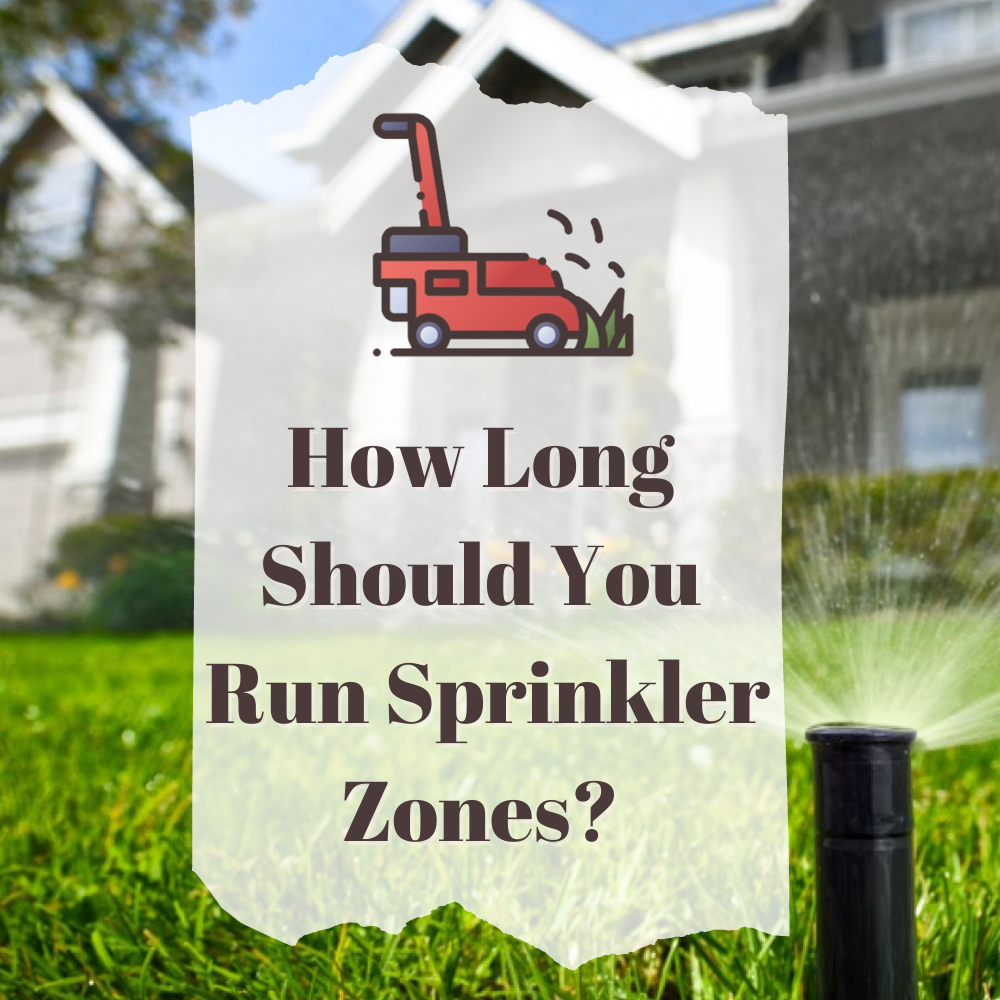
As a homeowner, maintaining a beautiful and healthy landscape is a top priority. One of the essential tasks in achieving this is by ensuring that your plants receive the right amount of water.
While watering your plants may seem like a straightforward task, it is crucial to understand how long you should run your sprinkler zones for, to avoid over or under watering your plants. Knowing how long to run your sprinkler zones depends on several factors such as soil type, plant species, sun exposure, and weather conditions.
In this article, I will guide you through the process of determining the right amount of water for your landscape, and how to set your sprinkler zone timer accordingly. By the end of this article, you will have a better understanding of how to keep your plants healthy and happy, and achieve a lush and thriving landscape.
Understanding Your Landscape’s Water Needs
Get to know how much water your landscape requires to stay healthy and vibrant. Understanding your landscape’s water needs is crucial in determining how long you should run sprinkler zones.
Every plant has different requirements, depending on its species, age, and location in your yard. For instance, newly planted trees and shrubs need more water than established ones. Meanwhile, flowers and vegetables require consistent moisture to thrive.
Understanding your landscape’s water needs starts with identifying the type of soil, climate, and sun exposure in your area. Once you have gathered this information, you can determine the amount of water your plants need and adjust your sprinkler system accordingly.
To ensure that your plants receive enough water, you need to know how much water your sprinkler system delivers. You can determine this by performing a catch-can test. Simply place several shallow cans, such as tuna cans or soup cans, in each sprinkler zone and run the system for 15 minutes.
Measure the amount of water in each can and calculate the average. This will give you an idea of how much water your sprinklers deliver per minute. You can then adjust your sprinkler system’s run time accordingly.
Keep in mind that your plants’ water needs will vary depending on the weather conditions and the season. By understanding your landscape’s water needs and regularly checking your sprinkler system’s output, you can keep your plants healthy and vibrant all year round.
Identifying Your Soil Type
Knowing the type of soil in your yard is crucial in determining the appropriate watering schedule for a healthy and thriving lawn.
There are three main types of soil: sandy, clay, and loam. Sandy soil drains quickly, making it difficult to retain moisture, while clay soil absorbs water slowly and can easily become waterlogged. Loam soil, on the other hand, is a mixture of sand, clay, and organic matter, making it the ideal soil type for most plants.
To determine your soil type, you can conduct a simple soil test. Dig a small hole in your yard and fill it with water. If the water drains quickly within 10 minutes, you likely have sandy soil. If the water drains slowly and the hole retains water for several hours, you likely have clay soil. If the water drains slowly but the hole doesn’t retain water for too long, you likely have loam soil.
Once you know your soil type, you can adjust your watering schedule accordingly to avoid overwatering or underwatering your lawn.
Evaluating Your Plant Species
Evaluating your plant species is crucial for a thriving lawn as different plants have varying water requirements. Some plants, like succulents, are adapted to dry environments and can survive on very little water.
On the other hand, plants like ferns and hostas require consistently moist soil to grow properly. It’s important to research the water needs of each type of plant in your lawn to avoid over or under watering.
In addition, certain plants may require more water during certain times of the year. For example, grass may require more water during the hot summer months to maintain its green color and prevent drought stress.
By understanding the specific water needs of your plant species, you can create a watering schedule that is tailored to your lawn and ensures that each plant receives the appropriate amount of water for optimal growth and health.

Factoring in Sun Exposure
If you want to ensure a thriving lawn, it’s crucial to factor in sun exposure and understand how it impacts the water needs of your plant species.
Generally, plants that are exposed to more sunlight require more water than those that are in the shade. This is because heat and light increase evaporation rates, which means that the water in the soil will be depleted faster. Additionally, plants that are exposed to the sun for longer periods will generally have deeper roots, which means that they will require more water to reach them.
When factoring in sun exposure, it’s important to consider the time of day that your sprinkler system is running. It’s best to avoid watering during the hottest part of the day, as this will increase evaporation rates and decrease the amount of water that reaches the roots of your plants.
Instead, it’s best to water early in the morning or in the evening, when the sun is not as strong. This will help to ensure that the water is able to reach the roots of your plants and provide them with the hydration that they need to thrive.
Calculating the Right Amount of Water
To ensure your lawn stays healthy, let’s figure out the perfect amount of water to give your plants. It’s important to calculate the right amount of water for each sprinkler zone, as overwatering can cause just as much damage as underwatering.
The easiest way to do this is by determining the precipitation rate of each zone. To calculate the precipitation rate, you’ll need to measure the amount of water that is emitted by each sprinkler head in your zone. You can do this by placing empty tuna cans or rain gauges throughout the zone and running your sprinklers for a set amount of time.
Once you’ve collected the water, measure the depth of water in each container and divide by the time you ran the sprinklers. This will give you the precipitation rate in inches per hour. With this information, you can determine how long to run each zone to deliver the right amount of water.
For example, if your zone has a precipitation rate of 1 inch per hour and you want to deliver 1/2 inch of water, you’ll need to run your sprinklers for 30 minutes. By calculating the right amount of water, you’ll not only save on your water bill, but also ensure that your lawn and plants receive the perfect amount of hydration.
Setting Your Sprinkler Zone Timer
Calculating the right amount of water is just the first step in ensuring your lawn gets the right amount of hydration. The second step is setting your sprinkler zone timer. This is crucial because it determines how long each zone will receive water and how often it will receive it.
To set your sprinkler zone timer, you’ll need to start by deciding how often you want to water your lawn. This will depend on factors such as the climate, the type of grass you have, and the soil type.
Once you’ve determined the frequency, you can then set the duration for each zone. A good rule of thumb is to aim for around 1 inch of water per week, which can be divided into two or three watering sessions.
If you have sandy soil, you may need to water more frequently for shorter periods, while if you have clay soil, you may need to water less frequently for longer periods.
By taking the time to set your sprinkler zone timer correctly, you’ll be able to ensure your lawn gets the right amount of water at the right times, helping it stay healthy and lush all year round.

Adjusting for Weather and Seasonal Changes
Don’t let unpredictable weather and seasonal changes ruin your lawn’s health – learn how to adjust your sprinkler timer for optimal hydration.
During hot summer months, you may need to increase the amount of time your sprinkler zones run to keep up with the increased heat and potential drought conditions.
On the other hand, during cooler fall and spring months, you may be able to decrease the amount of time your sprinkler zones run since there is typically more natural moisture in the air.
It’s important to regularly monitor your lawn’s hydration needs and adjust your sprinkler timer accordingly. This will not only save water and money, but it will also promote a healthy and vibrant lawn.
Additionally, if you experience sudden weather changes, such as an unexpected rainstorm, be sure to turn off your sprinkler system to avoid overwatering.
By being mindful of weather and seasonal changes, you can keep your lawn looking its best all year round.
Conclusion
Overall, determining how long to run your sprinkler zones requires a bit of trial and error. However, you can create a customized watering schedule by taking into account factors such as your landscape’s water needs, soil type, plant species, sun exposure, and weather changes.
Remember to regularly evaluate and adjust your watering schedule as needed, and don’t hesitate to consult with a professional landscaper or irrigation specialist for additional guidance. With a little bit of effort and attention, you can ensure that your lawn and garden remain lush and beautiful throughout the year.
